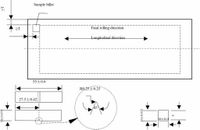In a pivotal study published on March 21, 2025, researchers examined the effects of post-weld heat treatment (PWHT) on the impact performance and microstructural behaviors of pressure vessel steel, which plays a critical role in the safety of equipment used in various high-temperature environments.
Their research revealed significant findings: the heat treatment process altered the microstructure and properties of the steel considerably. Initial tests showed the steel primarily consisted of 50% bainite and 50% ferrite, contributing to robust low-temperature impact toughness. Following PWHT at 690 °C for 24 hours, however, substantial changes were observed. Notably, the size of carbides, critical for steel strength and ductility, surged from an average of 110 nm in the delivered state to 360 nm after treatment—an increase of 227%.
This transformation was not merely quantifiable; it had a dramatic effect on the steel's performance. The impact energy, which is crucial for understanding a material's capability to absorb energy without failing, plummeted from 116 J to just 43 J after PWHT. Such a decline raises concerns for the reliability of pressure vessel steel in operational scenarios, particularly for components exposed to immense stress.
The methodology employed in this study was comprehensive and involved a series of tests designed to characterize the microstructure and impact toughness of the steel under different treatment conditions. Using both traditional metallographic methods and advanced electron microscopy, the researchers meticulously analyzed the subtle changes occurring at the microscopic level.
The outcome revealed that the increased carbide size and a change in carbide type from Cr7C3 to Cr23C6 significantly weakened the material. The authors of the article emphasized, "The most significant change observed during the transformation from small-sized Cr7C3 carbides in the original state to larger-sized Cr23C6 after post-weld heat treatment (PWHT) is the dramatic reduction in the steel's properties." This statement underscores the fundamental insight that the conditions following welding can critically undermine structural integrity, making it essential for manufacturers to refine their processes.
Furthermore, the study drew attention to how the high proportion of large-angle grain boundaries at 37.2% in the steel's matrix plays a role in its ability to resist crack propagation, thereby enhancing toughness. The researchers concluded that adequate microstructural refinement, combined with appropriate PWHT parameters, is crucial for maintaining the impact toughness of this vital material.
These insights come at a time when the petrochemical and coal chemical industries are pushing towards the utilization of larger and more complex configurations of pressure vessels. Understanding the relationship between heat treatment processes and the material properties of steel is paramount as these industries continue to evolve and face increasing demands.
The authors also indicated the importance of controlling the PWHT duration, recommending that treatment processes exceeding 24 hours at elevated temperatures should be avoided to prevent excessive carbide coarsening, which is detrimental to impact properties. This critical guidance aims to balance the enhancement of properties necessary for robust performance against the risks of reduced toughness.
Ultimately, the study illuminates an important dimension of steel preparation. As industries evolve, ensuring safety while maximizing performance remains a significant challenge. Correctly assessing and adapting post-weld treatment protocols could mean the difference between reliable operation and catastrophic failure in pressure vessel applications.
This research signifies a vital step forward in material science, affirming the necessity for continued advancement in thermal and mechanical processing to optimize the characteristics of pressure vessel steel, thereby securing safer industrial applications.




